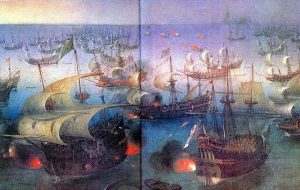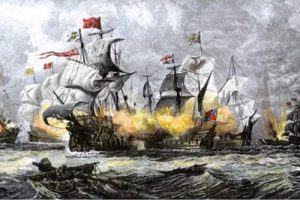Source:Revista de Historia
Anglo-Saxons refer to it as the English Armada, Counter Armada, or Drake-Norris Expedition. This last name is due to the fact that the expedition was commanded by Sir Francis Drake, who served as admiral of the fleet and by Sir John Norreys as general of the landing troops.
Counter Armada, objectives
The English Counter Armada had three objectives. The most important, to destroy the bulk of the Invincible Armada, which was being rebuilt on the Cantabrian coast, as no less than 102 Spanish ships were being repaired in the shipyards.
21 July 2020
The second objective was to take Lisbon and to crown Crato’s prior, Antonio de Crato, cousin of Felipe II aspiring to the Portuguese crown, who was travelling with the expedition.
The third objective was to take the Azores islands as an English base to try to capture the West Indies Fleet. The latter would allow England to have a permanent base in the Atlantic from which to attack Spanish convoys from America, which would be a significant advance towards the longer-term goal of wresting control of the trade routes to the New World from Spain.
Counter Armada, financing, and planning.
The English Armada was financed as an investment in the stock market, that is, Queen Elizabeth paid one quarter and the Dutch, allies of the English, one eighth; the Portuguese aspiring King, Antonio de Crato, also invested the money and the Portuguese Crown jewels that he had stolen. Thus, in April 1589 the expedition set sail with almost 150 ships, including six galleons, and 25,000 men.
The English at that time had no experience in organising large naval campaigns, so their logistics were very poor. Bad weather and the delay of the Dutch caused a third of the provisions to be consumed before leaving port. In addition, there were only 1,800 veteran soldiers compared to 19,000 novice and untrained volunteers, who did not carry the siege weapons essential to take fortresses, nor the cavalry essential to handle charges in ground operations.
Another controversial point was the decision to grant command of the squad to Sir Francis Drake. Although Drake had achieved notable successes acting as a corsair and pirate, and also took full credit for the operations against the Spanish Invincible Armada, a merit that various historians doubt. Subsequent events would show that Drake was not the right man to command a great naval expedition.
Counter Armada, the operation begins
From the first moment, the lack of discipline of the English crews was noticeable. Well before seeing the Spanish coast, a score of small boats had already deserted, with a total of about 2,000 men on board. Added to this was the disobedience of Drake himself, who refused to attack Santander as ordered, alleging unfavourable winds and the fear of being surrounded by the Spanish fleet in the Bay of Biscay or running aground in the Cantabrian Sea.
Instead, Drake decided to head to the Galician city of La Coruña. The reasons that led him to make this decision are not clear, but there may have been two fundamental reasons: firstly, Drake’s desire to repeat his success of 1587 when he attacked Cádiz, since rumour had it that there was a fabulous treasure valued at millions of ducats, which was false; on the other hand, La Coruña was the starting point for numerous Spanish fleets, which is why it had large reserves of provisions.
The attack on La Coruña failed due to the incredible tenacity and bravery of the Coruñeses among whom was the popular heroine in the city of La Coruña: Doña María Mayor Fernández de la Cámara y Pita, better known as María Pita.
Legend has it that her husband died in the fighting and, when an English second lieutenant was rallying his troops at the foot of the walls, Doña María went over him with a pike and pierced him, also snatching the banner from him, which caused the final collapse of the morale of the attackers.
4 January 2013
After the failure of La Coruña, the English went to Lisbon, where they were once again defeated, ending the operation in a total defeat without precedent for the English and which constituted a resounding failure of comparable dimensions to those of the famous Spanish Invincible Armada.
After the defeat of the Counter Armada, Spain rebuilt its fleet, which quickly increased its maritime supremacy to extremes superior to those before the Invincible Armada. This supremacy lasted almost 50 more years.
As a result of this disaster, the former popular hero in England, Sir Francis Drake, fell from grace.
Share this article
On This Day
- 1552 Battle of Bicocca.
- 1565 Miguel López de Legazpi founds Cebu as Villa de San Miguel.
- 1806 María Cristina de Borbón Dos Sicilias was born.
History of Spain
26 August 2020
27 January 2021
Communism: Now and Then
23 December 2022
28 July 2021

















